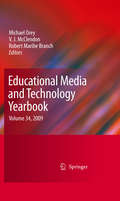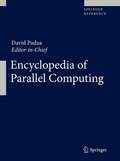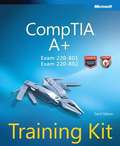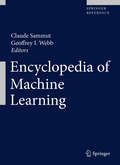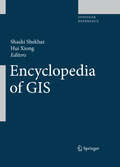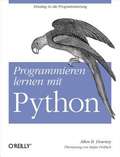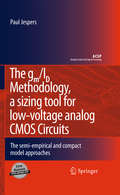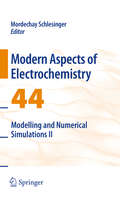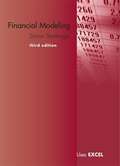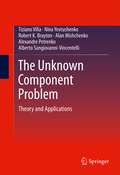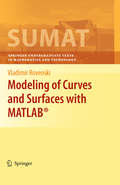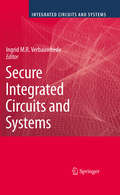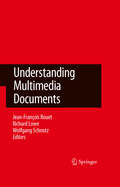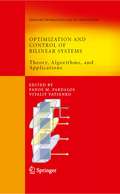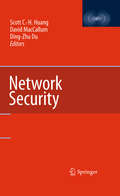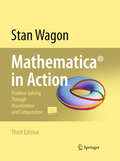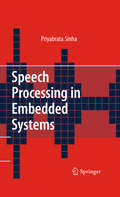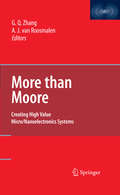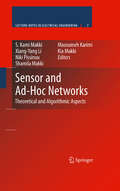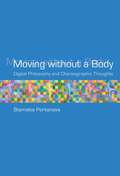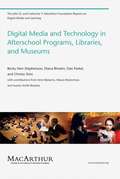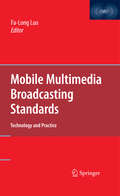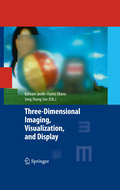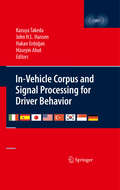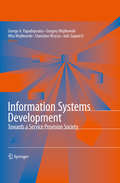- Table View
- List View
Educational Media and Technology Yearbook, Volume 34
by Robert Maribe Branch V. J. Mcclendon Michael OreyThe Educational Media and Technology Yearbook is dedicated to theoretical, empirical and practical approaches to educational media development. All chapters are invited and selected based on a variety of strategies to determine current trends and issues in the field. The 2009 edition will highlight innovative Trends and Issues in Learning Design and Technology, Trends and Issues in Information and Library Science, and features a section that lists and describes Media Related Organizations and Associations in North America. <P><P> The Educational Media and Technology Yearbook, a scholarly resource for a highly specialized professional community, is an official publication of the AECT and has been published annually for 33 years.
Encyclopedia of Parallel Computing
by David PaduaContaining over 300 entries in an A-Z format, the Encyclopedia of Parallel Computing provides easy, intuitive access to relevant information for professionals and researchers seeking access to any aspect within the broad field of parallel computing. Topics for this comprehensive reference were selected, written, and peer-reviewed by an international pool of distinguished researchers in the field. The Encyclopedia is broad in scope, covering machine organization, programming languages, algorithms, and applications. Within each area, concepts, designs, and specific implementations are presented. The highly-structured essays in this work comprise synonyms, a definition and discussion of the topic, bibliographies, and links to related literature. Extensive cross-references to other entries within the Encyclopedia support efficient, user-friendly searchers for immediate access to useful information. Key concepts presented in the Encyclopedia of Parallel Computing include; laws and metrics; specific numerical and non-numerical algorithms; asynchronous algorithms; libraries of subroutines; benchmark suites; applications; sequential consistency and cache coherency; machine classes such as clusters, shared-memory multiprocessors, special-purpose machines and dataflow machines; specific machines such as Cray supercomputers, IBM's cell processor and Intel's multicore machines; race detection and auto parallelization; parallel programming languages, synchronization primitives, collective operations, message passing libraries, checkpointing, and operating systems. Topics covered: Speedup, Efficiency, Isoefficiency, Redundancy, Amdahls law, Computer Architecture Concepts, Parallel Machine Designs, Benmarks, Parallel Programming concepts & design, Algorithms, Parallel applications. This authoritative reference will be published in two formats: print and online. The online edition features hyperlinks to cross-references and to additional significant research. Related Subjects: supercomputing, high-performance computing, distributed computing
CompTIA A+ (Exam 220-801 and Exam 220-802) Training Kit
by Darril GibsonCompTIA A+ Exams 220-801 and 220-802 candidates can ace their preparation with this training kit that allows them to work at their own pace through a series of lessons and practical exercises, and then assess their computing technology skills with the online practice test--featuring multiple, customizable testing options to meet their specific needs.
Encyclopedia of Machine Learning
by Claude Sammut Geoffrey I. WebbThis comprehensive encyclopedia, in A-Z format, provides easy access to relevant information for those seeking entry into any aspect within the broad field of Machine Learning. Most of the entries in this preeminent work include useful literature references.
Encyclopedia of GIS
by Shashi Shekhar Hui XiongThe Encyclopedia of GIS provides a comprehensive and authoritative guide, contributed by experts and peer-reviewed for accuracy, and alphabetically arranged for convenient access. The entries explain key software and processes used by geographers and computational scientists. Major overviews are provided for nearly 200 topics: Geoinformatics, Spatial Cognition, and Location-Based Services and more. Shorter entries define specific terms and concepts. The reference will be published as a print volume with abundant black and white art, and simultaneously as an XML online reference with hyperlinked citations, cross-references, four-color art, links to web-based maps, and other interactive features.
Programmieren lernen mit Python
by Allen B. DowneyPython ist eine moderne, interpretierte, interaktive und objektorientierte Skriptsprache, vielseitig einsetzbar und sehr beliebt. Mit mathematischen Vorkenntnissen ist Python leicht erlernbar und daher die ideale Sprache für den Einstieg in die Welt des Programmierens. Das Buch führt Sie Schritt für Schritt durch die Sprache, beginnend mit grundlegenden Programmierkonzepten, über Funktionen, Syntax und Semantik, Rekursion und Datenstrukturen bis hin zum objektorientierten Design. Jenseits reiner Theorie: Jedes Kapitel enthält passende Übungen und Fallstudien, kurze Verständnistests und kleinere Projekte, an denen Sie die neu erlernten Programmierkonzepte gleich ausprobieren und festigen können. Auf diese Weise können Sie das Gelernte direkt anwenden und die jeweiligen Programmierkonzepte nachvollziehen. Lernen Sie Debugging-Techniken kennen: Am Ende jedes Kapitels finden Sie einen Abschnitt zum Thema Debugging, der Techniken zum Aufspüren und Vermeiden von Bugs sowie Warnungen vor entsprechenden Stolpersteinen in Python enthält. Starten Sie durch: Beginnen Sie mit den Grundlagen der Programmierung und den verschiedenen Programmierkonzepten, und lernen Sie, wie ein Informatiker zu programmieren.
The gm/ID Methodology, a sizing tool for low-voltage analog CMOS Circuits
by Paul JespersIC designers appraise currently MOS transistor geometries and currents to compromise objectives like gain-bandwidth, slew-rate, dynamic range, noise, non-linear distortion, etc. Making optimal choices is a difficult task. How to minimize for instance the power consumption of an operational amplifier without too much penalty regarding area while keeping the gain-bandwidth unaffected in the same time? Moderate inversion yields high gains, but the concomitant area increase adds parasitics that restrict bandwidth. Which methodology to use in order to come across the best compromise(s)? Is synthesis a mixture of design experience combined with cut and tries or is it a constrained multivariate optimization problem, or a mixture? Optimization algorithms are attractive from a system perspective of course, but what about low-voltage low-power circuits, requiring a more physical approach? The connections amid transistor physics and circuits are intricate and their interactions not always easy to describe in terms of existing software packages. The gm/ID synthesis methodology is adapted to CMOS analog circuits for the transconductance over drain current ratio combines most of the ingredients needed in order to determine transistors sizes and DC currents.
Modelling and Numerical Simulations II
by Mordechay SchlesingerThis volume is meant as an introductory resource aimed at practitioners of electrochemistry research, technology, and development mainly at the atomic, molecular or macromolecular levels. Thus emphasis is placed at length scales in the 1-100 nm range. The volume will help provide understanding of electrochemical phenomena and materials at the nanoscale through modeling and numeric simulations. It also serves as a means to create and use structures, electrochemically based devices, and systems that possess novel properties and functions because of their small or intermediate sizes.
Financial Modeling (3rd Edition)
by Simon BenningaToo often, finance courses stop short of making a connection between textbook finance and the problems of real-world business. Financial Modeling bridges this gap between theory and practice by providing a nuts-and-bolts guide to solving common financial models with spreadsheets. Simon Benninga takes the reader step by step through each model, showing how it can be solved using Microsoft Excel. The long-awaited third edition of this standard text maintains the "cookbook" features and Excel dependence that have made the first and second editions so popular. It also offers significant new material, with new chapters covering such topics as bank valuation, the Black-Litterman approach to portfolio optimization, Monte Carlo methods and their applications to option pricing, and using array functions and formulas. Other chapters, including those on basic financial calculations, portfolio models, calculating the variance-covariance matrix,and generating random numbers, have been revised, with many offering substantially new and improved material. Other areas covered include financial statement modeling, leasing, standard portfolio problems, value at risk (VaR), real options, duration and immunization, and term structure modeling. Technical chapters treat such topics as data tables, matrices, the Gauss-Seidel method, and tips for using Excel. The last section of the text covers the Visual Basic for Applications (VBA) techniques needed for the book. The accompanying CD contains Excel worksheets and solutions to end-of-chapter exercises.
The Unknown Component Problem
by Alberto Sangiovanni-Vincentelli Alan Mishchenko Alexandre Petrenko Tiziano Villa Robert K. Brayton Nina YevtushenkoThe Problem of the Unknown Component: Theory and Applications addresses the issue of designing a component that, combined with a known part of a system, conforms to an overall specification. The authors tackle this problem by solving abstract equations over a language. The most general solutions are studied when both synchronous and parallel composition operators are used. The abstract equations are specialized to languages associated with important classes of automata used for modeling systems. The book is a blend of theory and practice, which includes a description of a software package with applications to sequential synthesis of finite state machines. Specific topologies interconnecting the components, exact and heuristic techniques, and optimization scenarios are studied. Finally the scope is enlarged to domains like testing, supervisory control, game theory and synthesis for special omega languages. The authors present original results of the authors along with an overview of existing ones.
Modeling of Curves and Surfaces with MATLAB®
by Vladimir RovenskiThis text on geometry is devoted to various central geometrical topics including: graphs of functions, transformations, (non-)Euclidean geometries, curves and surfaces as well as their applications in a variety of disciplines. This book presents elementary methods for analytical modeling and demonstrates the potential for symbolic computational tools to support the development of analytical solutions. The author systematically examines several powerful tools of MATLAB® including 2D and 3D animation of geometric images with shadows and colors and transformations using matrices. With over 150 stimulating exercises and problems, this text integrates traditional differential and non-Euclidean geometries with more current computer systems in a practical and user-friendly format. This text is an excellent classroom resource or self-study reference for undergraduate students in a variety of disciplines.
Secure Integrated Circuits and Systems
by Ingrid M.R. VerbauwhedeOn any advanced integrated circuit or "system-on-chip" there is a need for security. In many applications the actual implementation has become the weakest link in security rather than the algorithms or protocols. The purpose of the book is to give the integrated circuits and systems designer an insight into the basics of security and cryptography from the implementation point of view. As a designer of integrated circuits and systems it is important to know both the state-of-the-art attacks as well as the countermeasures. Optimizing for security is different from optimizations for speed, area, or power consumption. It is therefore difficult to attain the delicate balance between the extra cost of security measures and the added benefits.
Understanding Multimedia Documents
by Richard Lowe Jean-Francois Rouet Wolfgang SchnotzProfessionals who use multimedia documents as a tool to communicate concepts will find this a hugely illuminating text. It provides a comprehensive and up to date account of relevant research issues, methodologies and results in the area of multimedia comprehension. More specifically, the book draws connections between cognitive research, instructional strategies and design methodologies. It includes theoretical reviews, discussions of research techniques, ad original experimental contributions. The book highlights essential aspects of current theories, and trends for future research on the use of multimedia documents.
Optimization and Control of Bilinear Systems
by Panos M. Pardalos Vitaliy A. YatsenkoCovers developments in bilinear systems theory Focuses on the control of open physical processes functioning in a non-equilibrium mode Emphasis is on three primary disciplines: modern differential geometry, control of dynamical systems, and optimization theory Includes applications to the fields of quantum and molecular computing, control of physical processes, biophysics, superconducting magnetism, and physical information science
Network Security
by Ding-Zhu Du Scott C.-H. Huang David MaccallumThis book provides a reference tool for the increasing number of scientists whose research is more or less involved in network security. Coverage includes network design and modeling, network management, data management, security and applications.
Mathematica® in Action
by Stan WagonPlenty of examples and case studies utilize Mathematica 7's newest tools, such as dynamic manipulations and adaptive three-dimensional plotting. Emphasizes the breadth of Mathematica and the impressive results of combining techniques from different areas. Whenever possible, the book shows how Mathematica can be used to discover new things. Striking examples include the design of a road on which a square wheel bike can ride, the design of a drill that can drill square holes, and new and surprising formulas for p. Visualization is emphasized throughout, with finely crafted graphics in each chapter.
Speech Processing in Embedded Systems
by Priyabrata SinhaSpeech Processing has rapidly emerged as one of the most widespread and well-understood application areas in the broader discipline of Digital Signal Processing. Besides the telecommunications applications that have hitherto been the largest users of speech processing algorithms, several non-traditional embedded processor applications are enhancing their functionality and user interfaces by utilizing various aspects of speech processing. "Speech Processing in Embedded Systems" describes several areas of speech processing, and the various algorithms and industry standards that address each of these areas. The topics covered include different types of Speech Compression, Echo Cancellation, Noise Suppression, Speech Recognition and Speech Synthesis. In addition this book explores various issues and considerations related to efficient implementation of these algorithms on real-time embedded systems, including the role played by processor CPU and peripheral functionality.
More than Moore
by Alfred Van Roosmalen Guo Qi ZhangIn the past decades, the mainstream of microelectronics progression was mainly powered by Moore's law focusing on IC miniaturization down to nano scale. However, there is a fast increasing need for "More than Moore" (MtM) products and technology that are based upon or derived from silicon technologies, but do not simply scale with Moore's law. This book provides new vision, strategy and guidance for the future technology and business development of micro/nanoelectronics.
Sensor and Ad-Hoc Networks
by Xiang-Yang Li Kia Makki S. Kami Makki Niki Pissinou Masoumeh Karimi Shamila MakkiThis book brings together leading researchers and developers in the field of wireless sensor networks to explain the special problems and challenges of the algorithmic aspects of sensor and ad-hoc networks. The book also fosters communication not only between the different sensor and ad-hoc communities, but also between those communities and the distributed systems and information systems communities. The topics addressed pertain to the sensors and mobile environment.
Moving without a Body
by Stamatia PortanovaDigital technologies offer the possibility of capturing, storing, and manipulating movement, abstracting it from the body and transforming it into numerical information. In Moving without a Body, Stamatia Portanova considers what really happens when the physicality of movement is translated into a numerical code by a technological system. Drawing on the radical empiricism of Gilles Deleuze and Alfred North Whitehead, she argues that this does not amount to a technical assessment of software's capacity to record motion but requires a philosophical rethinking of what movement itself is, or can become. Discussing the development of different audiovisual tools and the shift from analog to digital, she focuses on some choreographic realizations of this evolution, including works by Loie Fuller and Merce Cunningham. Throughout, Portanova considers these technologies and dances as ways to think -- rather than just perform or perceive -- movement. She distinguishes the choreographic thought from the performance: a body performs a movement, and a mind thinks or choreographs a dance. Similarly, she sees the move from analog to digital as a shift in conception rather than simply in technical realization. Analyzing choreographic technologies for their capacity to redesign the way movement is thought, Moving without a Body offers an ambitiously conceived reflection on the ontological implications of the encounter between movement and technological systems.
Digital Media and Technology in Afterschool Programs, Libraries, and Museums
by Anne Balsamo Christo Sims Becky Herr Stephenson Dan Perkel Maura Klosterman Susana Smith Bautista Diana RhotenDigital media and technology have become culturally and economically powerful parts of contemporary middle-class American childhoods. Immersed in various forms of digital media as well as mobile and Web-based technologies, young people today appear to develop knowledge and skills through participation in media. This MacArthur Report examines the ways in which afterschool programs, libraries, and museums use digital media to support extracurricular learning. It investigates how these three varieties of youth-serving organizations have incorporated technological infrastructure and digital practices into their programs; what types of participation and learning digital practices support; and how research in digital media and learning can contribute to better integration of technology within and across these organizations. The authors review a range of programs (including the long-running Computer Clubhouse movement, established in 1993 in partnership with MIT's Media Lab), and then use the idea of "media ecologies" to investigate the role that digital media play (or could play) in these "intermediary spaces for learning." They call for less anecdotal, more empirical and methodologically sound studies to help us understand the affordances of digital media for learning within and across these programs; for research focused on the relationship between digital media and the effectiveness of youth-serving organizations; and for further study of schools within childhood media ecologies.
Mobile Multimedia Broadcasting Standards
by Fa-Long LuoThis volume provides a comprehensive and cohesive compilation of multi-standards and systems for mobile multimedia broadcasting. The material includes coverage of the basic principles, algorithms, and design trade off as well as examples of software and hardware that have been implemented at the system level. The first part of the book deals with system, implementation, compatibility and comparison of all the co-existing standards related to mobile TV and multimedia broadcasting including T-DMB, DAB, DVB-H/T, CMMB, Media-FLO, ISDB-T and WiMAX, ATSC digital TV and NTSC analog TV. The second part covers fundamental principles, algorithms, design and testing for baseband processing in mobile multimedia broadcasting. The third part consists of compression, transmission, error concealment, quality assessment and real-time implementation of video coding in broadcasting systems with emphasis on H.264 and AVS-M. The last four chapters are on the standards for audio coding, classification and surround effects. An overview of China's DRA audio coding standard and MPEG-4 AAC standard family (AAC, High Efficiency AAC and High Efficiency AAC Version 2) is given. The work also explains the general concepts behind spatial audio coding which are playing a very important role in digital audio/multimedia broadcasting systems for multi-channel contents. Mobile Multimedia Broadcasting Standards: Technology and Practice is an invaluable reference for engineers, researchers, broadcasters, manufacturers, network operators, software developers, content providers and others involved in the delivery of multimedia enriched contents to mobile systems.
Three-Dimensional Imaging, Visualization, and Display
by Bahram Javidi Fumio Okano Jung-Young SonThis book will describe recent developments, as well as the prospects and challenges facing 3D moving picture systems and devices, including binocular, multi-view, holographic, and image reproduction techniques. Optical systems, display instruments, and image capture techniques will be covered. The online supplement will include full color movies of experiments describing recent advances in 3D movies. This is the first state-of-the-art book on this subject that efficiently integrating the background material with new advances and applications and includes movies of 3D display systems.
In-Vehicle Corpus and Signal Processing for Driver Behavior
by Kazuya Takeda Hakan Erdogan John Hansen Huseyin AbutIn-Vehicle Corpus and Signal Processing for Driver Behavior is comprised of expanded papers from the third biennial DSPinCARS held in Istanbul in June 2007. The goal is to bring together scholars working on the latest techniques, standards, and emerging deployment on this central field of living at the age of wireless communications, smart vehicles, and human-machine-assisted safer and comfortable driving. Topics covered in this book include: improved vehicle safety; safe driver assistance systems; smart vehicles; wireless LAN-based vehicular location information processing; EEG emotion recognition systems; and new methods for predicting driving actions using driving signals. In-Vehicle Corpus and Signal Processing for Driver Behavior is appropriate for researchers, engineers, and professionals working in signal processing technologies, next generation vehicle design, and networks for mobile platforms.
Information Systems Development: Towards a Service Provision Society
by Gregory Wojtkowski Wita Wojtkowski Stanislaw Wrycza Jože Zupancic George Angelos PapadopoulosThis volume of Information System Development, Towards a Service Provision Society is the published proceedings of the 17th International Conference on Information Systems Development (ISD2008) that was hosted by the Department of Computer Science of the University of Cyprus at the Annabelle Hotel, Paphos, Cyprus from August 25-27, 2008. The theme of the conference was "Towards a Service Provision Society". In total, 131 delegates from 34 different countries registered for the conference, making it a truly international event. Papers presented at the conference strongly reflected the conference theme. Of 165 papers submitted, 99 were presented at the conference, representing an acceptance rate of approximately 60%. All papers were peer reviewed by three or four referees (a total of 543 review reports were submitted, corresponding to an average of 3.29 reviews per paper). Over the course of three days, 28 paper sessions were held, covering a range of areas such as: "Information Systems Engineering & Management", "Business Systems Analysis & Design", "Intelligent Information Systems", "Agile and High-Speed Systems Development Methods", "Enterprise Systems Development & Adoption", "Public Information Systems Development", "Information Systems Development Education", "Information Systems Development in Developing Nations", "Legal and Administrative Aspects of Information Systems Development", "Information Systems Research Methodologies", "Service-Oriented Analysis and Design of Information Systems", "IT Service Management", "Philosophical and Theoretical Issues in Information Systems Development", "Model-driven Engineering in ISD", "Human Computer Interaction (HCI) in Information Systems Development". The book is organised by order of the conference sessions. While all the presented papers were of high quality, we have selected two of them to share the Best Paper Award. The first one is: "Modeling the contribution of enterprise architecture practice to the achievement of business goals" by Marlies van Steenbergen & Sjaak Brinkkemper. The second one is: "Why can't we bet on ISD Outcomes?: ISD "Form" as a Predictor of Success" by Mike Newman, Shan L Pan & Gary Pan. Furthermore, to acknowledge the quality of the reviews he completed, the quality of the paper he submitted, his role as a track and session chair, and his general participation in the conference, we have awarded an Ovreall Contribution Award to Michael Lang of the National University of Ireland, Galway. Details of these awards can be found on the conference Web site at http://isd2008.cs.ucy.ac.cy. Our gratitude is extended firstly to all those who attended and authored work for the conference. The contribution of the International Program Committee was invaluable in identifying track chairs and reviewers to commit to doing vital work. While volunteering to host a conference is a highly personal undertaking, without support it would be impossible. Thus, we wish to thank our sponsors for their financial support and other aid. The ISD conference community has developed over the years a real sense of collegiality and friendliness, perhaps unusually so for a conference. At the same time it has been a stimulating forum where a free exchange of views and perspectives is encouraged. Perhaps what brings the community together is a belief that the process of systems development is important; whether it is systematic or structured or improvised or spontaneous, there is something about the process and the outcomes that excites us. We form a spectrum of thought from those who see the activity as somewhat scientific to others that see it as wholly sociological; we span a divide between abstract and conceptual, to hard code and artefacts - somewhere in-between lies the truth. If our work is to make a meaningful contribution to both practice (by teaching students) and research (by sharing our experiences and studies with others), then hopefully this conference will have done a little of the former and much for the latter.
